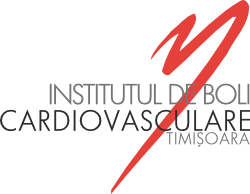The Institute of Cardiovascular Diseases Timisoara is a unit with legal personality established by Order of the Minister of Public Health no. 1452/04.11.1993 with headquarters in the municipality of Timisoara, Str. Gheorghe Adam, no. 13A having an external section - Cardiovascular Rehabilitation Clinical Section, section belonging to our unit, located in Timisoara, Constantin Diaconovici Loga str., no. 49.
The Institute of Cardiovascular Diseases Timisoara operates as a public health unit that provides complete cardiology medical care: clinical cardiology, interventional cardiology and cardiac catheterization, monitoring and treatment of critical cardiac patients, cardiovascular surgery, intensive care anesthesia, cardiovascular recovery and prevention, cardiovascular electrophysiological functional explorations, implant cardiac stimulators and defibrillators, non-invasive explorations and specialized outpatients, serving both the inter-county area and patients from other areas of the country and abroad; having attributions in higher medical education and sanitary environment, medical scientific research and specialized methodological guidance.
Being a unit with legal personality administratively subordinated to the Ministry of Health, the Institute of Cardiovascular Diseases Timisoara is an autonomous unit with its own income and expenditure plan, having the right to independently dispose of budget transfers granted by the Ministry of Health for national health programs (AP - IMA and AP - ATI) and budget credits for investments and endowments and "health actions" for the payment of resident doctors, also benefiting from financing from own revenues that come from the amounts collected for medical services and other benefits based on the contract concluded with the Health Insurance House in accordance with Law 95 /2006 and from other sources, according to the law, as well as for the financing of the National Program for the Prevention and Combating of Cardiovascular Diseases.
According to the organizational structure of the Institute of Cardiovascular Diseases Timisoara approved by the Minister of Health through WHO no. 1584/30.12.2013 The Institute of Cardiovascular Diseases Timisoara belongs to the "specialty hospital" type - providing specialized medical care, clinical cardiology, in connection with other complementary specialties. being classified
Depending on the provision of highly specialized medical assistance, the attributions in the field of higher medical and post-secondary education and the health environment, medical scientific activity, medical scientific research and specialized methodological guidance, the Institute of Cardiovascular Diseases Timisoara is cataloged as an "institute" - specialized medical assistance unit that also carries out educational and scientific-medical research, guidance and methodological coordination in its fields of activity, as well as continuing medical education, based in the Timisoara University Center. Depending on the competence and in relation to the objectives, the volume of activity and the technical endowment, the Institute of Cardiovascular Diseases Timisoara, by WHO no. 763/26.05.2011, is a health unit of IM category, type II of clinical medical institutes and centers, according to OMSP no. . 1501/2006, having 166 beds for continuous hospitalization and 15 beds for day hospitalization.
According to WHO no. 1664/2006 and WHO no. 1085/2012, regarding the functioning of regional emergency functional units, a collaboration protocol no. 4784/07.12.2012 for establishing the responsibilities and attributions of the operational management and the collective management of the Timisoara Regional Emergency Functional Unit, between the Institute of Cardiovascular Diseases Timisoara, the Timisoara County Emergency Clinical Hospital, the Timisoara Municipal Emergency Clinical Hospital, the Emergency Clinical Hospital for Children "Louis Turcanu" Timisoara. IBCVT received the status of regional emergency hospital grade IIB. The Institute of Cardiovascular Diseases Timisoara, in the exercise of its functions, collaborates with the central and local bodies of power and state administration and other organizations interested in protecting the health of the population.



